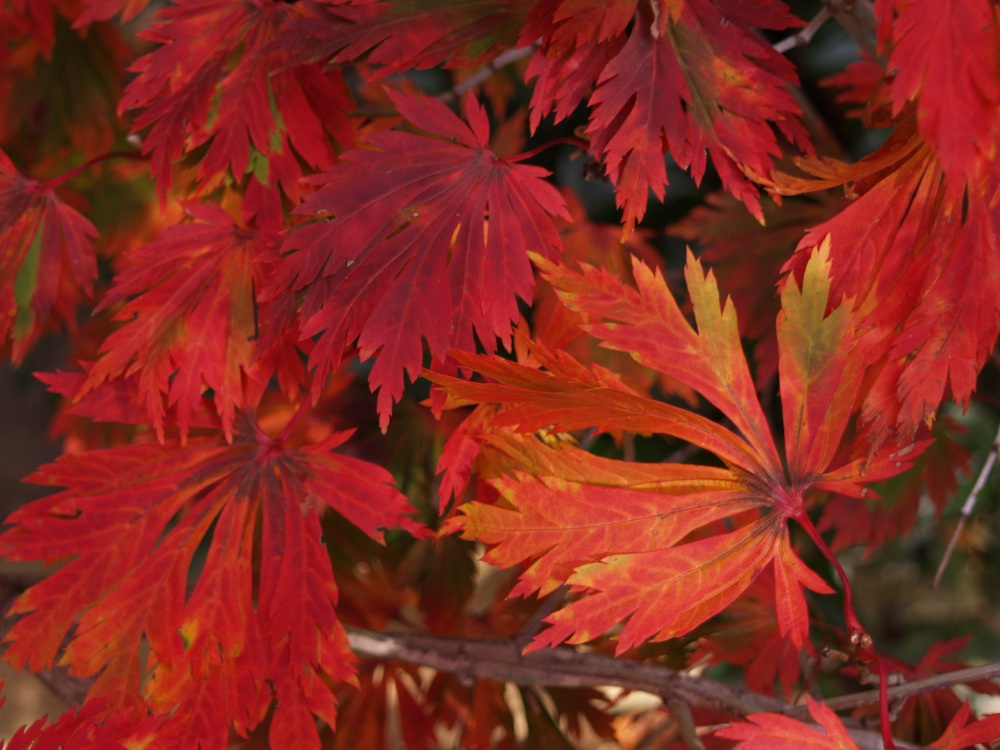No doubt, days through October and early November are the most splendid of the year, with low humidity, and cool, clear afternoons. There are times when a few weeks in September will have delightful weather, though the month can also be dreadfully hot. In recent years September has been abnormally wet, with late season hurricanes and tropical storms that have dumped many inches of rain, but this year the month was dry and cool, and certainly the equal of our typical October.
I suspect that due to September’s dryness, autumn foliage colors have been a bit more muted than usual, though I hesitate to make such pronouncements since I’ve seen sumacs (Rhus) and dogwoods that are as vivid as in any year. Mature poison ivy vines (Toxicodendron radicans) that climb far up into tulip poplars also seem particularly colorful.
In my garden the foliage colors of dogwoods are nearly as splendid as ever, though not the best I’ve seen. The hybrid dogwoods (Cornus x ‘Celestial Shadow’, above) are exceptional, and these seem more consistent from year to year with less variation than the native and Chinese dogwoods (Cornus kousa). The red berries of the native dogwoods (Cornus florida, below) are gone already, and while I don’t keep records of such things, this seems early for the birds to have stripped them bare.
The Golden Full Moon Japanese maple (Acer shirasawanum ‘Aureum’, below) had no significant color this year. This is consistently one of the best trees for its autumn foliage, but It is prone to dropping foliage early in a drought. By late October it had few leaves remaining, with the color unremarkable. This Japanese maple will often display mottled colors of red and yellow, and most years it is quite magnificent. And, then there are years such as this when there is nothing at all.
It seems that many people do not consider Japanese maples for their autumn foliage, and thus red leafed varieties are most popular. I’ve planted a handful of red leafed maples in the garden, but most are green (or variegated), and with the exception of the Full Moon maple, I expect the autumn foliage will be as magnificent as ever. Many do not color much until late in October, but then they hold their leaves through much of November.
The Fernleaf maple (Acer japonicum ‘Aconitifolium’, above) is the best of the Japanese maples for autumn foliage in my garden, though it seems not to be highly regarded and is rarely planted, I suspect because its large, deeply divided leaves are not as delicate as other maples. The tree is a bit more wide spreading than other upright growing Japanese maples, but the foliage mottled with reds and yellows is ample reason to include the tree as a favorite in my garden. The leaves begin to turn early in October, but do not reach their full glory until November, so the display lasts for nearly two months.
The colors of Japanese stewartia (Stewartia pseudocamellia, above) and Carolina silverbell (Halesia carolina) are more muted now than in their best years, but the Oakleaf hydrangeas (Hydrangea quercifolia, below) turned slowly to deep burgundy through October, and the foliage will often persist into early December.
Ginkgo (Ginkgo biloba) is the odd tree that changes to a golden, glowing yellow in early October, then drops its leaves all at once. One day the tree is fully leafed, and the next it’s bare with a carpet of yellow beneath. That happened ten days ago, so while other trees are at their peak, the ginkgo is bare.